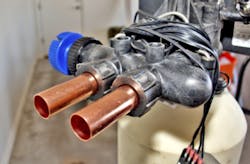Assessing water softeners and chloride discharge
BIRMINGHAM, Ala. — In the June issue of Water Technology, we discuss how water softener manufacturers use technology to combat chloride discharge.
Innovations help manufacturers limit chloride while increasing efficiency and performance. The article also explores softener alternatives like “salt-free” solutions.
While U.S. Environmental Protection Agency (EPA) standards require municipal wastewater facilities to comply with permits, chloride is not usually reduced. Bans and restrictions on softeners has also led to the creation of softening alternatives.
Mindsets have also shifted regarding this equipment over the years, notes the article. Various studies have been conducted to show people the benefits of water softeners despite the chloride discharge issues.
Since water softeners can marketed as eco-friendly solutions because of a decrease in necessary soaps and other cleaning products, manufacturers are often encouraged to find ways to reduce brine. Hellenbrand Inc. President Jeff Hellenbrand believes the investment is worth it. “Yes, dealers will need to reinvest in their rental fleets in many of these markets to improve their efficiencies, but that is way better than the alternative: a water softener ban,” he says in the article.
The article also addresses several softening alternatives, including:
- Physical water treatment systems may break down scale without the use of chemicals or salts.
- No-salt, or anti-scale, systems are said to decrease scaling by using media to form hardness crystals.
- Portable exchange tanks send waste discharge to the dealer’s treatment facility, taking responsibility away from the homeowner.
- Electro deionization is a newer technology to the market. It reduced ionic impurities with electricity.
In conclusion, the article states markets exist for traditional and alternative systems. Dealers should be knowledgeable about the pros and cons of each technology.
Click here to read the entire article.
